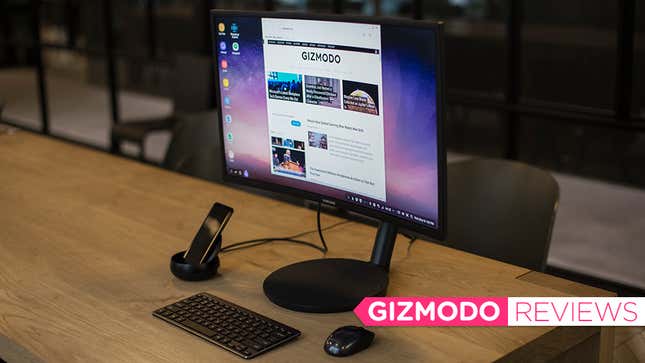
The Samsung Dex is a tiny new smartphone dock that wades carefully toward a world in which smartphones serve as our primary computers. It’s about the size of a hockey puck, and when the Galaxy S8, a monitor, and a Bluetooth keyboard and mouse are connected, the Dex turns the phone into a surprisingly functional desktop. The idea is that instead of lugging a laptop around everywhere, you might just take your phone and drop it into a dock at home, the office, and so on.
The concept of docking a smartphone and turning it into a fully functional PC is an ambitious dream that has failed spectacularly many times in the past. The Palm Foleo (never released), Motorola Atrix (massive flop), and Microsoft Continuum (never widely adopted) are just a few of the sad attempts to pull off the magical docking smartphone. Even if phones have more than enough computing power, the actual experiences have never lived up to the promise of a truly functional computer. But given how good the Galaxy S8 is, I had a reasonable expectation that Samsung might have finally cracked the nut.
The Dex sells for $150—which of course does not include the $750 price of the phone. The back of the device includes a swath of ports like HDMI out for video, USB-C for power, ethernet for stable internet, and two USB 2.0 ports for connecting a wired mouse and keyboard or a flash drive.

Setting up the Dex is relatively easy, and requires only two cables. The first time you set up the device, it takes a few minutes, depending on whether you have to move some furniture to route your cables. Every time after that, it’s as easy as plugging the phone into the Dex docking station. Within seconds, the Samsung logo appears on the screen, and only a few seconds after that, you’re looking at a familiar desktop environment.

The Dex user interface works like other popular operating systems. In the bottom left corner of the screen is an app launcher, similar to what you see in Chrome or Windows. At the bottom right, you’ll find all your settings. There’s also a task bar that shows you any programs are running along the bottom portion of the screen.
The most surprising aspect of using Dex is how fast it’s able to run different programs. I was able to easily run more than a dozen browser tabs while playing music in the background without a hint of lag.
But while the performance of the apps is good, the software experience lacks polish. Almost immediately I noticed that the Dex was unable to run all of the standard apps I downloaded on the Galaxy S8. In particular, I missed Slack and Spotify, which are essential for my workday—using the inferior browser versions of these apps just isn’t the same.
Little inconveniences compounded quickly. Because I couldn’t use Spotify, I’d switched to YouTube. But then, anytime I’d scroll past an autoplay GIF or video on Twitter or Facebook, my music would stop playing entirely.
I hit another major speed bump when discovered I couldn’t resize all of the apps. Some were fixed to the standard 16:9 ratio of a phone. I was surprised that even prominent apps like Facebook wouldn’t resize.
Despite these problems, I was resolved to stick with it, assuming that the main benefit of having a Dex would be portability. I brought my half-written review with me on a short trip to Chicago, and set up the dock on a different monitor. The setup process while traveling was kind of a pain in the ass, and ultimately, I regretted not just sticking to my trusty old laptop. The Dex didn’t make it easier to travel, and I imagine if I had a few Dex docking stations sitting in the various offices I work from (home, work, parents’ house), it wouldn’t really make a difference because the experience just can’t compare to what you get from a desktop OS.
At its best, using the Dex is like using a really crappy version of Chrome OS. The apps don’t always work correctly, and it doesn’t make anything much easier to do besides typing in a Word document. The saddest part is that I didn’t really need the dock to that. I could have just kept used the Bluetooth keyboard connected to the phone.
In the end, I found the Dex to be frustrating if somewhat promising. The power of the Galaxy S8 was more than enough to make me believe that we might someday use our smartphones as our primary computers. The Dex falls short of realizing this goal despite coming pretty damn close.
README
- Dex is super fast. I never experienced any lag, even after launching more than 10 apps.
- Not all apps work with DeX. Two of my favorites—Slack and Spotify—were not able to run in desktop mode.
- At $150 the DeX is just as expensive and not quite as practical as a cheap Chromebook.